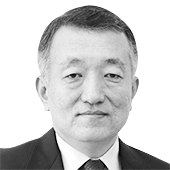Lift interest rates
Published: 22 Jun. 2021, 20:04

The author is a senior editorial writer of the JoongAng Ilbo.
Richard Nixon, fearing a chance of losing reelection in 1972, pressured U.S. Federal Reserve Chairman Arthur Burns to maintain loose monetary policy. When the chairman raised concern about excess liquidity, Nixon snapped back. “Liquidity problem is just bullshit,” he said, according to a taped conversation in October 1971. Nixon, who had put the economist from Columbia University into the post in 1970, made sure the rates stayed benign so as not to affect the presidential election. Monetary tightening has never been politically popular. The United States at the time was faced with runaway inflation due to fiscal expansion to finance the Vietnam War and welfare benefits. The central bank should have raised rates, but Nixon stopped it. The ramifications lasted a long time. After two rounds of oil shocks in 1973 and 1979, the U.S. entered a decade of stagflation, where prices surge despite a stagnant economy. Burns went down as one of America’s worst central bankers.
South Korea experienced a similar liquidity trap. In 2002, the final year of President Kim Dae-jung’s term, under-subscribed apartments were non-existent and prices soared. During parliamentary questioning, Bank of Korea (BOK) Gov. Park Seung said there was no other way than raising interest rates to soak up excess liquidity. But he nevertheless did not go through with it. Deputy Prime Minister for the Economy Jeon Yun-churl opposed a rate hike “as the move could cause a psychological panic among people and companies.” The Kim Dae-jung administration wished to end its term with strong growth to extend the ruling power through the coming presidential election in 2002.
The economy showed 7.4 percent growth that year. Ruling party candidate Roh Moo-hyun won the presidency. The plan worked. But then the piper had to be paid. The liberal president had big ideas of reforming the prosecution and moving the administrative capital. His administration was too absorbed in its radical election platform and overlooked fissures in the economy. A credit-financed boom went bust. Liquidity swelled into the real estate market. The Roh administration had to fight an overheated real estate market through his five-year term. It blocked loans and even went after single-home owners as speculators. Nothing worked. The problem was with liquidity. Still, interest rates were cut. The rates finally went up in October 2005, the third year of Roh’s term. But since rates were even lower than those in the U.S., liquidity was not tamed. Property prices kept rising.
The third liberal government under President Moon Jae-in also fell into the liquidity temptation. The U.S continued lifting its benchmark rates from the zero level until 2018 when the asset market finally shook off the shock of the 2008-2009 financial meltdown. But Korea stalled on the rate front. In 2018-2019, Korea’s interest rates became lower than the U.S.’s again. Liquidity was awash. To make matters worse, the rates came down last year to a record-low level due to the Covid-19 pandemic. Even as the economy contracted, housing and stock prices surged. Homes became unreachable for the young. They flocked to cryptocurrency markets with money borrowed at cheap rates. Liquidity is once again to be blamed.
Nothing is free. Following the liquidity binge, inflation bills have arrived in countries around the world. Prices of wood, iron ore and copper are at all-time highs. Global food prices jumped 40 percent last month. The Wall Street Journal likened the phenomenon to the nightmarish period of the 1970s under Nixon and Burns. Inflation is particularly hard on ordinary people. They feel the squeeze if the currency’s value depreciates.
Rates must go up before it’s too late. The burden inevitably will be heavy on struggling households and companies in debt. Columbia University economist Jeffery Sachs projects monetary tightening will be hard on debt-ridden governments and companies. But debt would pile up more if rates stay low. Private sector debt has reached 4,000 trillion won ($3.5 trillion) and government debt 1,000 trillion won. The Moon administration does not plan to cut spending ahead of the presidential election next year. Moon vowed to increase spending for economic recovery. The government is going down the path of doom from 1972 in the U.S. and 2002 in Korea.
The BOK is slow-moving and ambiguous. Governor Lee Ju-yeol said a rate hike could depend on economic development. The market considered the remark a harbinger of a hike within the year. Recently, Lee said loose monetary policy should be “normalized in orderly manner at the appropriate time.” We cannot know when the “appropriate” time may be. The BOK has rarely moved in the opposite direction of fiscal policy. Even if it acts, the rate hike will stop at 25 to 50 basis points.
We must be cool-headed. When rates go up, unrest will immediately follow. But if a rate hike is delayed, a bigger crisis can come. The government’s plan to keep up the liquidity binge to win the next presidential election on March 9 spells danger. The next government will have to clean up the mess. We do not want to see history repeat itself.










with the Korea JoongAng Daily
To write comments, please log in to one of the accounts.
Standards Board Policy (0/250자)